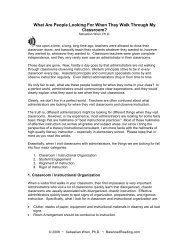The Abecedarian Reading Assessment - Balanced Reading
The Abecedarian Reading Assessment - Balanced Reading
The Abecedarian Reading Assessment - Balanced Reading
Create successful ePaper yourself
Turn your PDF publications into a flip-book with our unique Google optimized e-Paper software.
Alphabetic Principle<br />
It is important that children have phoneme awareness, and it is important that children be<br />
familiar with the letters of the alphabet. Research has shown that both of these things are<br />
essential to developing good reading skills. However, it is also important that children be<br />
aware that letters in text represent the phonemes in speech – that is the alphabetic<br />
principle, and it is the cornerstone on which all reading skill is built.<br />
Sometimes children can have phoneme awareness and letter knowledge, but still fail to<br />
see how they are related to each other. Children who do not understand the alphabetic<br />
principle do not understand what a “long” word is, nor do they understand that mature<br />
readers do not memorize words as wholes. Children’s natural tendency is to memorize the<br />
shape of words, or memorize some salient feature within words, but when they develop an<br />
implicit understanding of the alphabetic principle, they realize that to be a mature reader,<br />
they have to learn how to break words apart and sound them out.<br />
<strong>The</strong> task for the Alphabetic Principle subtest is relatively easy – the child looks at two<br />
words; one is long and the other short. <strong>The</strong> teacher says one of the words out loud, and<br />
the child points to the word the teacher said. It is important to note that a child can do this<br />
task without actually reading the word. <strong>The</strong> child only needs to be able to decide which<br />
word is longer or shorter to be successful at this task.<br />
Children who have difficulty with this task may benefit from a “reverse dictation” task – the<br />
teacher sits with the child and asks the child to dictate something for the teacher to write<br />
(one twist is to have the child make up nonsense words for the teacher to write). <strong>The</strong><br />
teacher will slowly model the writing process, asking the child to repeat the words slowly so<br />
that each sound can be written down accurately. <strong>The</strong>n the teacher models sounding the<br />
word out to recreate the spoken words. <strong>The</strong> child’s attention should be drawn to long<br />
words and short words, and the lesson should emphasize the fact that words that take a<br />
long time to say are written down as long words on the page.<br />
For more ideas about instructional activities that could be used to help children develop an<br />
understanding of the alphabetic principle, consult www.balancedreading.com.<br />
<strong>Abecedarian</strong> <strong>Reading</strong> <strong>Assessment</strong> • www.balancedreading.com • Page 21<br />
Alphabetic<br />
Principle



